Why Do Cats Headbutt?
- Decoding the Irresistible Charm
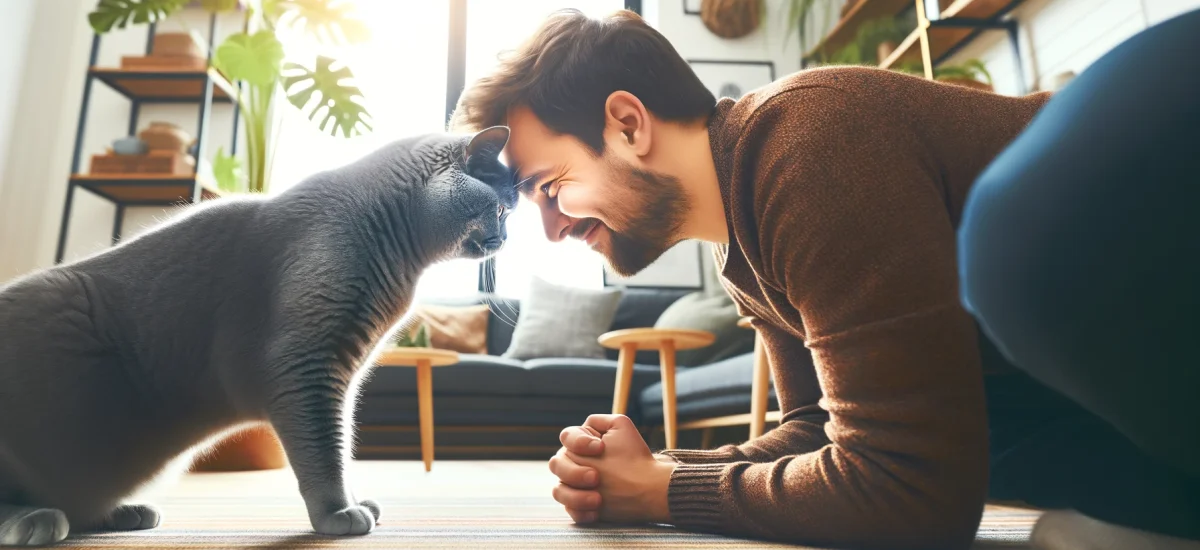
Why do Cats Headbutt?Quick Answer
|
Have you ever been sitting on the couch, minding your own business, when suddenly your furry feline friend comes sauntering over and gently butts their head against you?
Or maybe you’ve experienced the not-so-gentle version, where your cat seems to headbutt you with the force of a tiny wrecking ball!
If you’re a cat owner, chances are you’ve experienced this peculiar behavior known as headbutting.
When I was a first-time cat owner, I was surprised when this happened to me.
I was lounging in bed, scrolling through my phone, when my Siamese mix cat Mittens hopped up and started nudging her head against my arm insistently. At first, I thought maybe she wanted pets or treats, but after a few gentle headbutts, I realized this was something different altogether.
As a new cat parent, I was utterly perplexed by this strange display. Was she trying to get my attention? Was this some sort of feline head massage? Or was she simply a bit eccentric? I had so many questions swirling in my mind.
It wasn’t until I researched that I uncovered the fascinating reasons why cats headbutt their humans. And let me tell you, the explanations are as intriguing as the behavior itself!
So, if you’ve ever found yourself on the receiving end of a headbutt from your cat, rest assured, you’re not alone. In fact, it’s a tale as old as time (well, maybe not that old, but you get the idea).
Join me as we dive into the captivating world of cat headbutts and unravel the mysteries behind this peculiar feline ritual.
What the Heck is Headbutting, Anyway?
After being utterly baffled by Mittens’ headbutting antics, I knew I had to get to the bottom of this feline phenomenon.
What exactly is headbutting?
I did some digging. Some call it ‘head-butting.’ Others call it ‘head bumping, ‘ but it turns out this behavior has an official name—cat bunting.
Bunting is when a cat gently rubs or butts their head against a person or object. It can range from a soft, barely-there nudge to an almost forceful bonk that makes you worry for your cat’s noggin!
Some cats are such enthusiastic bunters that they’ll headbutt you with enough gusto to make your teeth rattle.
I quickly learned that my gentle-as-a-lamb Mittens was on the tamer end of the bunting spectrum. But her cousin Socks? That kitty headbutts like a tiny furry bowling ball! I’ve had to do a double-take more than once when his rock-hard skull makes sudden contact with my shin.
While the intensity may vary, all bunting boils down to the same core behavior—using one’s head to nudge, rub, or bonk against things (and people!) in one’s environment.
But why on earth do they do it?
As I dug deeper, I uncovered some fascinating explanations that make total sense when you think about our quirky feline friends.
It turns out that a cat’s headbutting, or bunting, is one of the many peculiar yet endearing ways that cats communicate and interact with their world.
From marking their territory to showing affection, your cat’s headbutts could be saying a lot more than you realized!
Reasons Behind Cat's Headbutts
Marking Their Territory
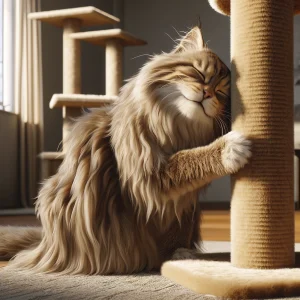 One of the biggest reasons behind Mittens’ headbutting antics seems to be a cat’s innate need to mark their territory with scent.
One of the biggest reasons behind Mittens’ headbutting antics seems to be a cat’s innate need to mark their territory with scent.
Those little bumps on their heads contain glands that release pheromones – like a personal fragrance to lay claim to their domain.
When I brought home a new cat tree for Mittens, I noticed her headbutting it frequently. Aha! By bonking her head against it, my furry girl was putting her own signature scent on her latest piece of furniture. It was her way of saying, “This is mine!”
The cat headbutting escalated again when I had guests over. Mittens made her rounds, bunting against legs, cushions, any new smells that entered her kingdom. In her mind, she was just reaffirming to those unfamiliar scents, “Don’t forget, this is MY turf!”
An Affectionate Gesture
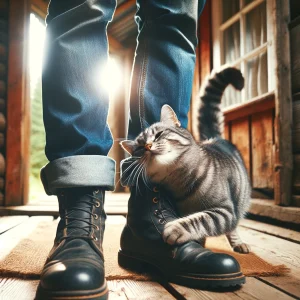 But territorial marking isn’t the only driver for those insistent headbutts. Our feline friends also use it as an endearing way to show affection and trust. It’s like their version of a heartfelt hug or kiss!
But territorial marking isn’t the only driver for those insistent headbutts. Our feline friends also use it as an endearing way to show affection and trust. It’s like their version of a heartfelt hug or kiss!
According to Jennifer Van de Kieft, a New York-based cat behavior expert, headbutting “is one of the ways cats show affection.”
As a former stray before I adopted her, it took time for Mittens to feel completely at ease. But when she started bunting my arm or leg while purring up a storm, I knew those headbutts translated to “You’re my human, and I love you.”
I’ll never forget when Mittens was a tiny kitten and would clamber into my lap, kneading my legs contentedly with those miniature paws. Then she would stretch her little body up to bunt the underside of my chin with her soft head. My heart melted every time – it was like receiving the most affectionate kitty headbutt kisses!
Attention-Seeking Antics
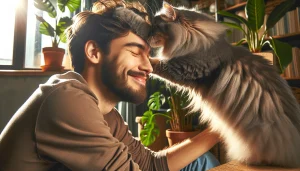 Of course, marking territory and showing affection aren’t the only reasons our feline friends employ those demanding headbutts. They’ve also become masters at using them to seek attention and engage with their favorite humans.
Of course, marking territory and showing affection aren’t the only reasons our feline friends employ those demanding headbutts. They’ve also become masters at using them to seek attention and engage with their favorite humans.
Let me tell you, Mittens definitely pulls this move when she wants some playtime or extra cuddles from me. I can’t count how often I’ve been working at my desk only to have her saunter up and assertively headbutt my arm or leg. When I glance down, she’s staring at me intently, sometimes even batting a toy my way in a not-so-subtle hint.
The message is clear: “Hey, pay attention to me!” Sometimes, it feels like she views my head as a big red “paw me” button to bonk whenever she wants some quality human engagement time. And really, how can I resist that precious furry face?
A Self-Soothing Behavior
While attention-seeking is one motivation, I’ve also noticed Mittens tends to use headbutting as a self-soothing behavior when she’s feeling anxious or stressed. Like when thunderstorms start brewing – she’ll hunker down beside me and press her head against my leg, almost like she’s trying to burrow herself into me for security.
Or after a particularly noisy event like construction sounds outside, she’ll come find me for some soothing cheek rubs and bunting against my arm. It’s like she’s wrapping herself in the coziest, most reassuring security blanket.
When you think about it, headbutting makes total sense as a calming mechanism for cats. Not only does it release soothing pheromones from their scent glands, but it also allows them to feel close and safe with their trusted humans or objects. For an anxious kitty, that’s a win-win!
So while headbutting may sometimes feel like a furry little battering ram assaulting our shins, most of the time it’s simply our cat’s uniquely adorable way of communicating their needs for bonding, play, security, and claiming their kingdom. And isn’t that just so quintessentially feline?
Decoding Those Headbutts
While I’ve learned that headbutting can have several different motivations for cats, reading their body language has been key in determining what those bonks actually mean in any given situation.
Headbutts of Affection
You see, not all headbutts are created equal. Sometimes when your furry friend bumps their little head against you, their whole demeanor is relaxed. They’re likely just giving you an affectionate bunting while making biscuits with their paws on your lap. This is their way of saying “You’re my favorite and I love you!”
The Attention-Seeking Bonk
Other times though, the headbutt comes with an intensely focused stare and maybe even some demanding meows or batted toys in your direction. In that case, your cat’s body language is screaming “Give me attention right meow!” They’ve engaged their headbutting tactics to ensure you don’t miss their not-so-subtle cues.
Anxiety and Reassurance
Then there are the headbutts that seem more like anxious nuzzling. Your kitty presses their head into you tightly, possibly after a startling noise or stressful event for them. Their pupils may be dilated and tail swishing with tension. These headbutts are your cat’s way of self-soothing and seeking your reassuring presence to feel secure.
A Concerning Head Press
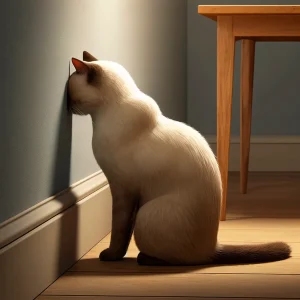 However, it’s also crucial to distinguish between normal, communicative headbutts and a potentially serious behavior called head pressing.
However, it’s also crucial to distinguish between normal, communicative headbutts and a potentially serious behavior called head pressing.
While they may seem similar at first glance, head pressing can actually indicate an underlying neurological issue in cats.
With a typical headbutt, your cat will bonk you with the top of its head in a conscious, seemingly intentional way—whether affectionate, attention-seeking, or anxious.
But head pressing involves your cat pressing its head directly against a surface with applied force, often against walls or corners. Their body may remain in that motionless position for an extended period.
If you notice this type of abnormal, zoned-out head pressing coupled with other concerning symptoms like circling, lack of appetite, or unprovoked aggression, it’s wise to consult your veterinarian promptly.
Head pressing can potentially signal serious conditions like brain tumors, head injuries, or feline leukemia that require medical evaluation.
The Importance of Observation
So, while those sweet (or sometimes not-so-sweet) headbands from your cat are usually just their unique way of communicating, it’s still important to closely observe the context and their overall behavior.
Paying attention to the details can allow you to properly interpret the difference between an affectionate bunting session and a potential medical emergency.
Responding to Your Cat's Headbutts
Encouraging vs. Discouraging
Now that we’ve covered the fascinating reasons behind headbutting and how to interpret your cat’s body language cues, you might wonder – so how exactly should I respond when your furry friend bonks you with their noggin?
The short answer is – it depends! Recognizing which motivations are driving those demanding headbutts can help you develop an appropriate response.
Sometimes, you’ll want to discourage and redirect that behavior, while other times, reinforcing it is perfectly acceptable.
A Redirection Lesson
Let me give you a personal example. When Mittens was a kitten, I’ll admit I inadvertently encouraged her attention-seeking headbutts a little too much. Whenever she’d forcefully bonk my legs while I was working, I’d give in and dote affection on her. Oops, I was basically rewarding and reinforcing that demanding behavior!
I quickly learned that for those headbutts aimed at getting my undivided attention, it’s better to redirect Mittens to an alternative activity first before giving her pets and playtime.
Maybe I set up a food puzzle or throw a wand toy to expend some of that rambunctious kitten energy first. That way, when I do give her my focused time, she understands she earned it through positive behavior rather than persistent headbonking.
Rewarding Affectionate Bonks
On the flip side, there are absolutely times when I want to encourage and reinforce Mittens’ headbutting habits. Like when she gently bunts my arm while making air biscuits on my lap – the ultimate display of kitty trust and affection.
In those cases, I respond with calm pets, treats, and all the praise a doting cat mom can give!
Calming Reassurance
The same goes for when she uses headbutting to self-soothe during stressful situations.
If I notice her anxiously pressing her head against me after a loud noise or upsetting event, I’ll speak to her softly, reassuringly while gently scratching that favorite spot behind her ears. Positive reinforcement for using headbutting as a calming mechanism.
Reading the Cues
It’s all about reading those body language signals we discussed earlier and channeling your cat’s headbutting motivations in a constructive way.
If the headbutts seem anxious or attention-seeking, try redirecting to an alternative like toys, food puzzles, or playtime before rewarding them with your focused affection.
On the other hand, when your cat is gently and contentedly headbutting you in a relaxed way, feel free to reinforce that adorable show of affection by rewarding them with treats, calming praise, and plenty of pets and scratches.
An Endearing Quirk
Because let’s be honest, as weird as headbutting can sometimes feel when you’re on the receiving end of those furry skull-battering rams, it’s just one more endearing quirk that makes our feline friends so unique and irresistible.
I’ve learned to embrace Mittens’ headbutting habits while shaping her bonking tendencies in a positive way.
At the end of the day, those headbutts are a love language of their own – one that transcends the language barrier between humans and cats through the universal novelty of a fuzzy little noggin bopping you affectionately.
And if that isn’t just the most peculiar yet charming way for our pets to show their love, I don’t know what is!
Final Thoughts: A Delightfully Peculiar Bond
As I’m sure you’ve gathered by now, the humble headbutt is so much more than just an occasionally startling bonk from your feline friend. It’s an intriguing insight into your cat’s mind and needs.
From serving as a territorial scent marker to being an expression of pure contentment and affection, headbutting is a unique part of the utterly quirky yet charming companionship we share with our cats.
While figuring out the difference between a demanding “pet me” headbonk and a self-soothing bunting session may sometimes feel like cracking the Da Vinci code, it’s also immensely rewarding. Suddenly, you find yourself tuning into every tail twitch, pupil dilation, and ear position like you’re studying feline behavior at a university level.
I know I had my fair share of head-scratching (pun very much intended) moments when Mittens first started her headbutting habits. Was she just being a weirdo? Did she have a secret vendetta against my shins? But everything clicked into place once I learned to interpret her body language cues and discern the “Pet me now!” headbutts from the “I’m feeling stressed” ones.
These days, I look forward to and even silently encourage those furry little head bonks from my girl. They’re like a morse code that clues me into her loafing language desires for play, grooming, snuggles, or just some good old-fashioned undivided attention and quality time together.
Mittens may be the queen of mixed signals at times, but at the end of the day, her headbutting habits have only brought us closer as besties. They’ve helped me become more attuned to her quirks, needs, and unique expressions of feline affection in a way I may have missed otherwise.
So, while the headbutting phenomenon may leave you with the occasional battle scar in the form of a stray forehead bump from an overly enthusiastic kitty, I’d argue it’s a small price to pay for such an endearing (and enduringly strange) way to bond with our furry companions.
Embrace the head bonks, folks – it’s just a part of the beautifully weird world of being a cat parent.
If you are interested to learn more about weird cat behaviors, check out this post on “Weird Cat Behaviors Explained-Why Cats Do the Strangest Things?”
Related Posts:
Why is my cat licking the floor? Bizarre or Normal?
Cat Zoomies Explained: Why Do Cats Suddenly Turn Into Cheetahs?
Why Do Cats Knock Things Over? – The Truth Behind This Mischievous Act
Cat ‘Making Biscuits’: The Quirky Reasons Behind Your Cat’s Kneading Habit
8 Hidden Reasons Why Your Cat Covers Their Food (Some May Surprise You!)
Fascinating Yet Creepy: Why Cats Stare at Empty Spaces?
7 Secret Reasons Why Cats Lift Their Bum When Petted – And It Will Melt Your Heart!
Why Cats Chew on Plastic: Unraveling This Bizarre Behavior
Why Do Cats Bring You ‘Gifts’? Unraveling the Mystery of Cat “Gift-Giving” Behavior
The Art of Cat Napping: Why Cats Sleep in the Strangest Places in the Funniest Positions
Cats and Boxes: Unlocking the Secrets Behind This Irresistible Obsession
The Secrets Behind Your Cat’s Bird-Watching Chirps and Chatters
Why do cats roll in dirt?
Why do cats rub their face on things?
Why cat rolls in dirt?
Why Do Cats Rub Their face on Things?
Please share this article if you think it deserves. Have a nice day!
